ZEN IRODALOM ZEN LITERATURE
« Zen index
« Home
十牛圖 Shiniu tu
The Ten Ox-herding Pictures
Verse by 廓庵師遠 Kuoan Shiyuan, 12th century
Translated by the
Chung Tai Translation Committee, Taiwan
Commentary talk by 聖嚴 Shengyan (birth name 張寳康 Zhang Baokang; 1930-2009)
Edited by Linda Peer and Harry Miller ~Class
summary courtesy of Rick Cabrera
Cf.
Hoofprint of the Ox: Principles of the Chan Buddhist Path as Taught by a Modern Chinese Master, Oxford University Press, 2002, 256 pages Revered by Buddhists in the United States and China, contemporary Master Sheng-yen shares his wisdom and teachings in this first comprehensive English primer of Chan, the Chinese tradition of Buddhism that inspired Japanese Zen. Often misunderstood as a system of mind games, the Chan path involves a process of self-transformation grounded in carefully hewn spiritual disciplines and premises. Master Sheng-yen provides an unprecedented understanding of Chan, its precepts, and its practice. Beginning with a basic overview of Buddhism and meditation, the book then details the progressive mental exercises traditionally followed by all Buddhists. Known as the Three Disciplines, these procedures develop moral purity, meditative concentration, and enlightening insight through the "stilling" of the mind. Master Sheng-yen then expounds Chan Buddhism, recounting its centuries-old history in China and illuminating its fundamental tenets. He contemplates the nature of Buddhahood, specifies thephysical and mental prerequisites for beginning Chan practice, and humbly considers what it means to be an enlightened Chan master.
Paintings by Chen Chao Bao, Taiwan, 2007
The Ten
Ox Herding Pictures
by Master Sheng-yen
Ch'an Newsletter - No. 119, November
1996
A talk delivered by
Master Sheng-yen on 10/22/92 and edited by Linda Peer and Harry Miller.
~Class summary courtesy of Rick Cabrera.
http://dharmatalks.riversidechan.org/2007/12/dharma-talk-november-07-2007.html
畫家陳朝寶 為太谷精舍禪堂 作於台灣 Pictures by artist: Chen, Chao
Bao, Taiwan, 2007.
Poems translated by the Chung Tai Translation Committee, 2007, 2010.
http://ctzen.org/sunnyvale/enUS/index.php?option=com_content&task=view&id=227&Itemid=57
http://ctzen.org/sunnyvale/enUS/images/pdf/sutras/20111101Sutras/13the%20ten%20oxherding%20pictures%20v7%2020100527.pdf
http://ctzen.org/sunnyvale/gallery/main.php?g2_itemId=502
http://ctzen.org/sunnyvale/gallery/main.php
The Ten Ox Herding Pictures are metaphors for the
process and progress of Ch'an practice. When China was an agricultural society,
people depended on oxen and buffalo to work their fields. These animals were
important, powerful and part of human life, so the analogy of ox herding was
meaningful to Buddhists of the time.
An early incidence of ox herding as a metaphor for practice can be found in a
story from the T'ang Dynasty (618-906). A monk was working in the monastery
kitchen when his master came in and asked what he was doing. He replied,
"Nothing much, just herding the ox."
The Master asked, "How are you herding
it?"
The monk replied, "Every time the ox wanders off to eat grass when he
should be working, I rein him in and put him back to work."
This story became a kung-an in which the ox represents the mind, which the ox
herder must train. In Ch'an practice, the emphasis is on mental, not physical,
practice. If the mind is not pure, there can be no purity in body and speech.
In the Lotus Sutra the white ox is a metaphor for transcendence of the cycle of
birth and death, or samsara. Anyone who sees the white ox sees the great
vehicle (of Mahayana Buddhism) which can be taken to Buddhahood.
Many versions of the ox herding pictures were created during the Sung Dynasty
(960-1279). They were often accompanied by poetry. The most famous is
attributed to K'uo-an Shih-yuan, a twelfth century Ch'an master of the Lin-chi
school. All versions illustrate the process and levels of Ch'an practice, as
well as the recognition of Buddha-nature, our original nature.
Do you believe that you have this ox, this Buddha-nature, within yourself? If
you have no faith in the existence of Buddha-nature, or in the possibility of
experiencing your intrinsic self then ox herding is irrelevant. If there is no
ox to herd, there can be no ox herding, no progression. This is true for people
who have no interest in discovering their intrinsic nature, as well as for
those who once held the ox and let it go.
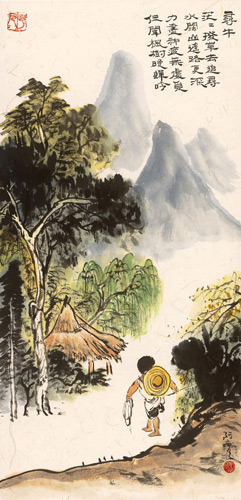
The first picture is "Looking for the Ox." It shows a beginning practitioner who has heard the teachings of the Buddha and believes we each have Buddha-nature and the ability to attain liberation. However, he has no personal experience of Buddha-nature and must use methods of practice, such as meditation and prostration, to discover the original self.
(一) 尋牛:茫茫撥草去追尋,水闊山遙路更深,力盡神疲無處覓,但聞楓樹晚蟬吟。
1. Searching for the Ox
Brushing aside thick grasses I
pursue him,
In wide rivers, distant mountains, and paths without end.
Exhausted, unable to find him anywhere,
I only hear evening cicadas in the maple trees.
In this stage, the cogitating mind is perceived as the true nature.
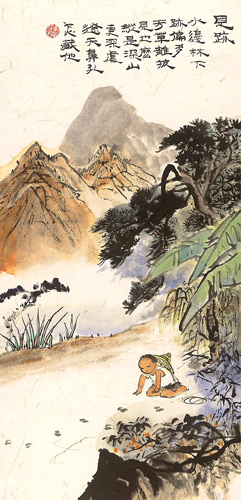
The practitioner discovers ox tracks in the second picture. His mind has begun to calm and he has a sense of something, but he sees that the ox is not easy to find. Searching for Buddha-nature is like looking for a mountain through a thick layer of clouds. Others say it is there, but you are uncertain of what you see. Is it a cloud or a mountain? The beginning practitioner has only seen tracks. Do they belong to the ox? At this point you are attracted to practice, and practice impels you to search. Practice enhances your faith. This is seeing the traces of the ox.
(二) 見跡:水邊林下跡偏多,芳草離披見也麼?縱是深山更深處,遼天鼻孔怎藏他?
2. Discovering the Footprints
Scores of footprints in the
forests and by the streams,
Do you see them scattered amid the fragrant grass?
Even deep in the remote mountains,
How can he conceal his enormous snout?
Tracking of the mind is represented in this picture. Mind begins to calm and
curiosity encourages one to practice more.
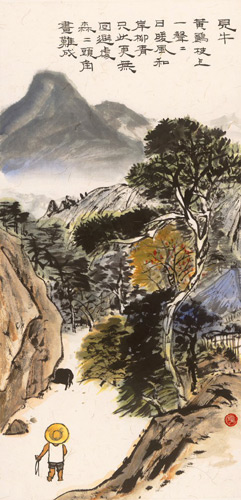
(三) 見牛:黃鸝枝上一聲聲,日暖風和岸柳青,只此更無回避處,森森頭角畫難成。
3. Sighting the Ox
A golden oriole trills on the
branch,
The sun is warm, the wind mild, and the lakeside willow green.
Now there is nowhere for the ox to escape!
Yet what artist can paint his majestic head and horns?
Here, the practitioner has seen the gaps between thoughts and the end of thoughts before another begins to rise again. He has seen a wisp of the quietness of mind. He realizes that there is no music if there are no gaps between the notes.
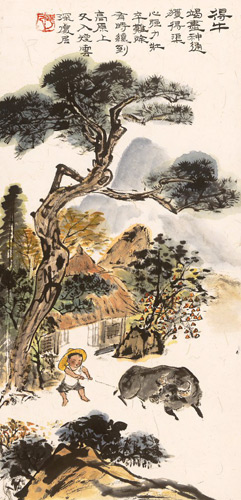
The
practitioner catches the ox and tries to control it with a rope in "Getting
the Whole Ox," the fourth picture. He perceives his own Buddha-nature, but
still experiences vexations caused by greed, anger, dislike and resentment. The
mind produces innumerable vexations in response to what is around him. Seeing
his intrinsic nature, the practitioner is careful not to give rise to vexations
and he knows the environment has no real, permanent existence. Still, he
experiences vexations and must use appropriate methods and views, such as
meditation and the understanding of causes and conditions, in order to deal
with these problems. The methods and views of Ch'an comprise the ox-controlling
rope.
(四)
得牛:竭盡神通獲得渠,心強力壯卒難除,有時纔到高原上,又入煙雲深處居。
4. Catching the Ox
With extraordinary effort I catch
the ox,
Strong of body and spirit, he is not easily subdued.
At times, he scales the lofty plains,
Then hides deep within the cloud-like mist.
The ego is tricking the practitioner and obstructing the practice causing wandering thoughts during the meditation method. This is where individual causes and conditions begin to work. At this point, it is up to the practitioner to learn to manage the bull or let the bull go astray. It is not easy to control mind when one succumbs to the ego. The practice will work with diligence and great faith.
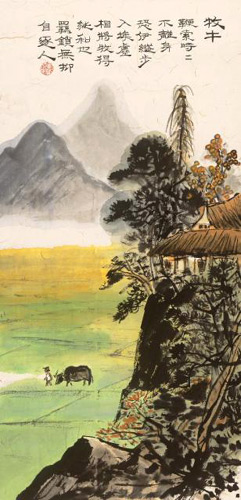
The fifth picture is simply called "Ox Herding." Now a sage, the practitioner easily leads the ox by the rope. He has progressed to somewhere between the eleventh and fortieth stage of Mahayana Bodhisattvahood. Though he has few vexations, he continues to practice diligently and make vows. The direction of the ox herder and the ox is now clear.
(五) 牧牛:鞭索時時不離身,恐伊縱步入埃塵,相將牧得純和也,羈鎖無抑自逐人。
5. Taming the Ox
I must never let go of the whip
and rein,
Lest he strides down the dusty trail.
Having been well trained, the ox is docile;
He freely follows the master without the leash.
With less ego, one has more control of life. Practice is beginning to pay off. The mind is stable; wisdom manifests in body speech and mind.
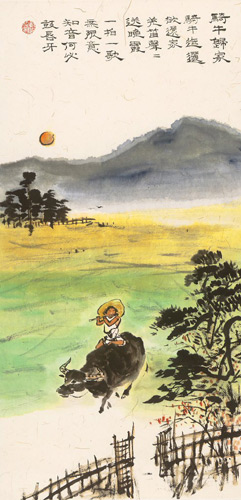
"Riding the ox home," the sixth picture, shows an ox well trained and obedient, familiar with the way. The ox herder rides effortlessly on its back, playing a flute. This is the first Bhumi position, or forty-first stage of Bodhisattvahood. The practitioner no longer needs conscious effort to continue to practice and make vows. The ox simply continues forward on the path. The practitioner's actions are appropriate to each situation.
(六) 騎牛歸家:騎牛迤邐欲還家,羌笛聲聲送晚霞,一拍一歌無限意,知音何必鼓唇牙。
6. Riding the Ox Home
Mounting the ox I meander home;
The sound of my flute rides with the evening clouds.
Each beat and tune holds meaning profound;
No need for words if you understand this song.
Freedom and ease of body and mind, the practitioner shares harmony with everyone. The softness attracts others to the practice.
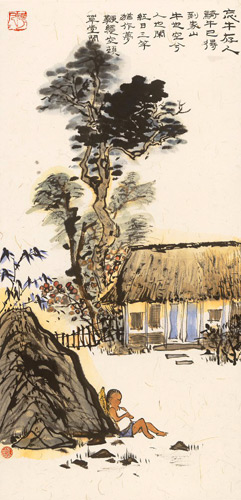
The seventh picture is "Forgetting the Ox." The ox has disappeared. Only the practitioner remains. This point is between the first and the eighth Bhumi stages, and between the forty-first and forty-seventh stage of the Bodhisattva path. The practitioner exerts no effort, and practices spontaneously, unconcerned with goals or purpose. Self cultivation ceases. Beginning practice is like swimming upstream. Great effort is required. Later the swimmer is one with the water. Is there still swimming?
(七) 忘牛存人:騎牛已得到家山,牛也空兮人也閑,紅日三竿猶作夢,鞭繩空頓草堂間。
7. The Ox Transcended
Astride the ox I reach my native
hill,
The ox has vanished, and I am free.
I dream until the sun is high;
The rein and whip lie idle in the barn.
The bull has been transcended, practitioner is one with the bull.
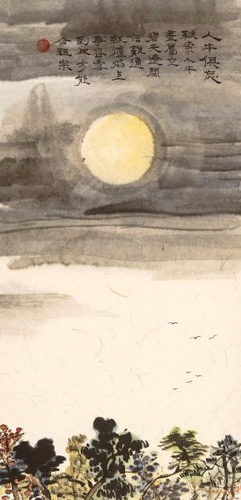
Both the ox and the ox herder have disappeared in the eighth picture. Only a circle, the frame of a picture, remains. The seventh picture removes the ox, which represents the world, the object. Finally, the subject, too, disappears in the eighth picture. Nothing remains. There is no goal and no practitioner.
(八) 人牛俱忘:鞭索人牛盡屬空,碧天寥闊信難通,紅爐焰上爭容雪,到此方能合祖宗。
8. Both Ox and Self Transcended
Whip, rein, person, and ox merge into emptiness,
No words can reach across this vast blue sky.
How can snow accrue on a burning stove?
Here finally, I walk with the Patriarchs.
Mind sees clearly, practitioner realizes causes and conditions.
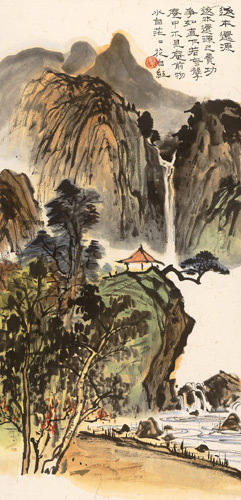
The ninth picture, "Return to the Origin," shows a mountain and a river. A novice practitioner sees mountains and rivers, but does not recognize them as such. Now the adept sees mountains as mountains, rivers as rivers. He has returned to the world. Everything exists but his attachments. There is no longer practice or no practice, wisdom or vexation. Everything is complete, everyone a Buddha and the environment a Buddha land.
(九) 返本還源:返本還源已費功,爭如直下似盲聾,庵中不見庵前物,水自茫茫花自紅。
9. Returning to the Source
Returning to one’s root has
taken much effort,
Better to have acted blind and deaf from the start!
Dwelling in my hut, I see nothing without,
Rivers flow, flowers are red.
The hills and mountains are all free of dust. Red is red and purple is purple.
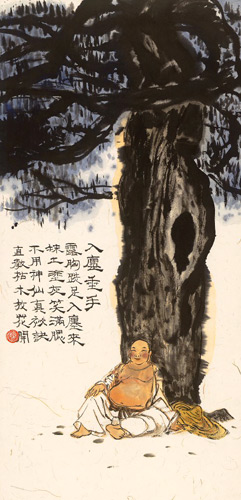
Traditionally, we see a beggar and a ragged, big-bellied monk in the tenth picture. The beggar represents suffering, the monk a practitioner who has completed his practice. He has left the isolation of the mountain and returned to the world to help all beings. He has no vexations, but because others suffer he spontaneously provides help on the path to all needful beings.
(十) 入廛垂手:露胸跣足入廛來,抹土塗灰笑滿腮,不用神仙真秘訣,直教枯木放花開。
10. Entering the World
Barefoot and bare-chested, I mingle with the world;
Though covered with dirt, I beam with joy.
Without the need for secret miraculous powers,
I make flowers bloom from withered wood.
This is the
ultimate function, the Mahayana function where one is able to give everything
that he/she has to others and still not lose any of it.
Please read Master Sheng-yen's important point on the next paragraph.
I have talked about each ox herding picture, but there is an important point to add. People sometimes adopt a selfish viewpoint from these pictures, because they suggest that we practice until we attain Buddhahood before we even begin to help sentient beings. This is not the way of Buddhism or Ch'an. As soon as the Buddha's teachings begin to benefit you in your life, you must begin to help sentient beings. Even at the very first stage of ox herding, you should help others. Don't simply wait for Buddhahood.
Question:
Is this gradual or sudden enlightenment?
Shih-fu: Going through these stages in order is not considered sudden
enlightenment. It is best called gradual enlightenment. People who experience
sudden enlightenment may share some of these experiences, but not necessarily
in this order. The Sixth Patriarch (638-713), who taught before the Pictures
were developed, never made reference to such a progression.
The Pictures are useful in representing the process of gradual enlightenment
and are studied by practitioners in China and Japan. With faith, we can all
seek the ox, Buddha-nature, within ourselves.